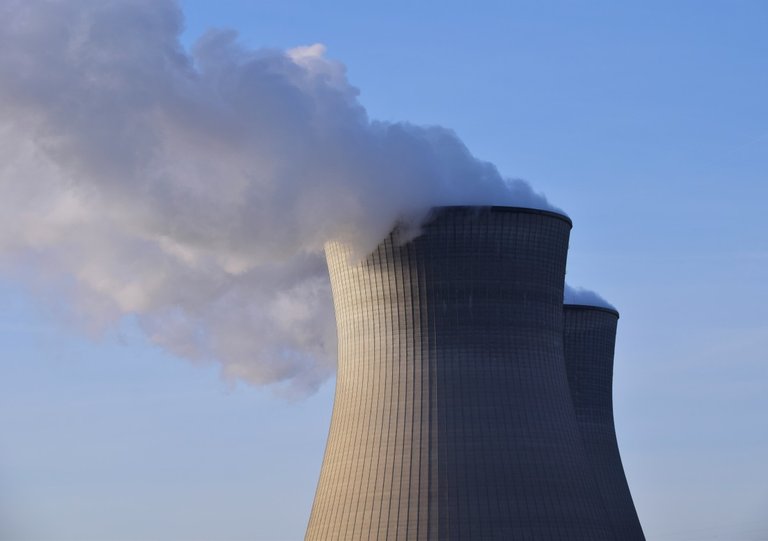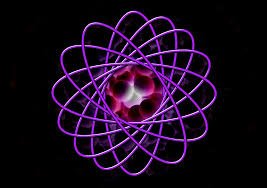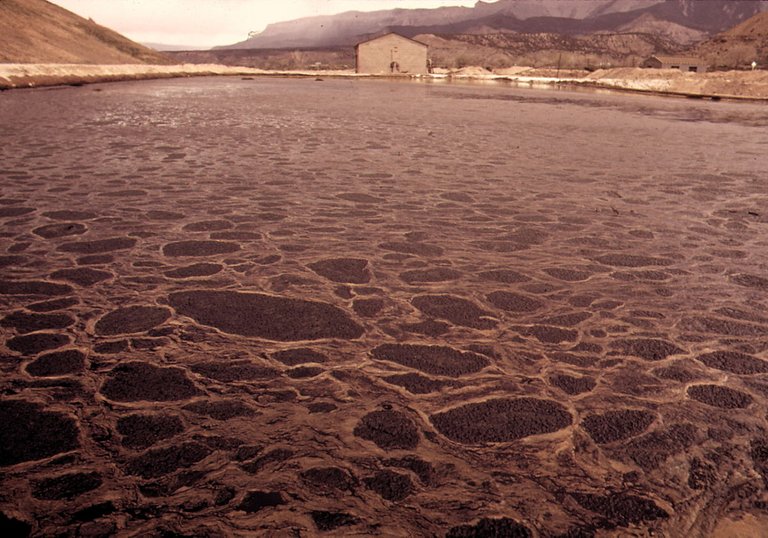Hello everyone, today we would continue with what we started a few days back, in the last post we started by talking about a nuclear power plant, how that heat is needed to boil water in every power plant and how heat energy is generated in a nuclear power plant.
Two major processes were explained in detail, nuclear fission and nuclear fusion, however something we didn’t go into the details of is how exactly the heat generated from this reaction can be quantified. These would form the major basis of our discussion today.
( )
)
Energy from a Nuclear plant pix from pxhere
Now an element is said to be radioactive majorly because it is unstable, of course unstable elements are elements in which its number of protons exceeds 83 (as in Bismuth nucleus).
This is because for smaller atomic number (<83) there is an equality between the number of protons and the neutrons of that element, however, as atomic number begins to increase the number of neutrons begins to be greater than the number of protons.
Basically what makes a nuclei stable is a strong nuclear force large enough to counterbalance its electrostatic force, this nuclear force is distance dependent, when the protons are at certain meters away form the core of the nucleus, the nuclear force diminish. (DO the rest folks!!!)
Very soon we would see a practical process through which we can actually measure the energy released during a fission reaction but before then let’s talk about the concept of atomic mass unit and binding energy.
SO WHAT’S ATOMIC MASS UNIT AND BINDING ENERGY
Take say a Carbon 12 atom, the neutron and the proton existing in its nucleus is equal in its apparent sense. But on separating The proton from the neutron, the summation of the masses independently is more than that mass. Therefore we define a.m.u as one-twelfth of the mass of Carbon-12 i.e 1.000u.
It is used as a measure the relative mass of an element to one-twelfth of an hydrogen atom (note I didn’t say Hydrogen atom as Hydrogen can exist in an unstable state having a higher mass number).
The mass of a neutron is quite higher than the mass of a proton
mass of proton = 1.67310-27 = 5.48610-4
Mass of neutron= 1.675 * 10-27 = 1.0087u
SO WHAT DOES THIS TEACH US ?
Lets take our cue from a Carbon atom, Carbon-12 has a mass of 12.0000u it has 6 protons and 6 neutrons in its nucleus.
We therefore see from the above relation that the a.m.u of a neutron and proton is 1.0087u and 1.0073u respectively which though is approximately higher than the 12.0000u.
While these difference might be small in magnitude, it posseses tremendous energy which accounts for the nuclear force that binds the protons and the neutrons together. These energy is called the ” binding energy” which can be defined as the energy released due to the mass defect of a nuclei.
From our mass-energy relation E=mc2
Where m or ∆m is the difference in both masses. The binding energy is given as ∆mc2.
Lets put some practicality to the equation now so we can as well get the gist.
During a fission of Uranium 235, lets calculate the energy release that accompanies the reaction.
The equation of the reaction is seen below
23592U+ 10n==> 14155Cs+9337Rb+210n
Here we have Uranium 235 splitted to give Rb and Cs and of cause a release of 2 moles of neutron, at this point I would like us to note that due to the law of conservation of mass and energy, (The products must always equal to the reactant) Which of course is the case from the above reaction.
But then it would interest you to know that at the end of every fission, the only tangible thing you would see is the both the Rb and Cs (Cesium) element. And it would hence look like the law of conservation of mass and energy is compromised. But know, you also have neutron particles, would have loved to talk more on that, but I don’t think I can talk about that without talking about sub-atomic particles… Then we would be leaving nuclear Physics to start talking about high energy particle Physics. Maybe we would do that in some other series.
Because the neutron particle might not be tangible to the eye doesn’t mean it doesn’t exist, it however can be seen through the use of an electron microscope.
PLEASE don’t let’s forget where we are coming from. We want to calculate the amount of energy from the above reaction and to do that we must first ensure the fission equation is balanced. (i.e. mass number and atomic numbers of each reacting element is equal to the total mass and atomic numbers of each product element)
The energy released during these reaction is equivalent to the mass before these reaction, therefore we get the difference in mass of product and reactant which is termed, ”Mass Defect”. Below is a summary of the mass of each element involved in the reaction
In a.m.u
144 55Cs = 143.932077 amu
9037 Rb = 89.914802 amu +
10n= 1.008665 amu
For the reactant
23592U= 235.043930
Therefore Massproduct - Massreactant
Gives us the mass defect.
Let’s do some computing
143.932077amu +89.914802amu +1.008665amu – 235.043930 amu = -0.188386 amu
Thus the mass defect ∆m = -0.188386
This mass is equivalent to the energy releases
∆mc2 = E
0.188386(3108)2
This incidentally gives us 1.695*1013 KJ
Isn't this tremendous !!!
Just for a minute mass, if we can realize such an energy from fission, then it we must learn how to control the process to prevent a massive explosion that can in turn lead to the death of many and many. E.g (Hiroshima and Nagasaki)
One major advantage of fission is the fact that on generating this high magnitude of energy, there is no need for burning fossil fuels (e.g Coal, Oil etc.) to generate energy and hence there is a greenhouse effect is greatly
SO FISSION MAKES US REDUCE GREEN HOUSE EFFECT, BUT AT WHAT
COST?
Ever heard of nuclear waste?
Though it is true that radioactivity impedes the effect of greenhouse effect and even generates more energy than burning of fossil fuels, It’s also note-worthy to consider that fission also has its fare share of disadvantage. Nuclear fission also ends up with residues (though in relatively small quantity) which is also highly toxic and harmful to the environment if not well managed.
These residues are so radioactive that standing close to it even for a few seconds would transfer a lethal dose of radiation which would eventually lead to death after some days, it is therefore more harmful than using other fossil fuels to generate energy . As harmful as it is.
THE GOOD NEWS IS THAT IT CAN BE AVOIDED:
As Harmful as that might be it is also avoidable, these radioactive wastes is always shielded from the environment, one of the best ways to do this is using water. Of course it cannot be shielded forever, but it surely should be shielded for as long as it would need to decay into less radioactive nuclei, though depending on its half-life this process tends to take at least some few years.
Its good news to note that many at times, these residues comprise 90% of Uranium which is a useful fuels, therefore recyclable, it is quite possible, though not yet common to pass these nuclear waste through certain chemical processes to filter out the usable fuel for further fission process.
It would interest you to know that under the same conditions the quantity of nuclear wastes is the same as the quantity of CO2.
Though it might seem that I am trying to make you see reason why nuclear means of energy production is better than the fossil fuel method but I am merely just providing you with facts.
By the next Volume of these series we would be going into more detail on nuclear power plants. Seriously I can’t wait to see you then.
CONCLUSION
We saw the tremendous energy that could be produced from just a small mass of Uranium today, we also saw the cost of producing energy of such magnitude (though preventable) which made us do a little comparison between nuclear energy and fossil fuel generated energy.
REFERENCES
For further reading you might want to check out the following
-https://whatisnuclear.com/waste.html
If you write STEM (Science, Technology, Engineering, and Mathematics) related posts, consider joining #steemSTEM on steemit chat or discord here. If you are from Nigeria, you may want to include the #stemng tag in your post. You can visit this blog by @stemng for more details.

You can also join us at Promo-Mentors, to improve your blogging skills. Join our discord channel and meet awesome mentors who are willing and ready to shape your writing skills.



Hello! I find your post valuable for the wafrica community! Thanks for the great post! We encourage and support quality contents and projects from the West African region.
Do you have a suggestion, concern or want to appear as a guest author on WAfrica, join our discord server and discuss with a member of our curation team.
Don't forget to join us every Sunday by 20:30GMT for our Sunday WAFRO party on our discord channel. Thank you.
This post has been voted on by the steemstem curation team and voting trail.
There is more to SteemSTEM than just writing posts, check here for some more tips on being a community member. You can also join our discord here to get to know the rest of the community!
Hi @lawkay!
Your post was upvoted by utopian.io in cooperation with steemstem - supporting knowledge, innovation and technological advancement on the Steem Blockchain.
Contribute to Open Source with utopian.io
Learn how to contribute on our website and join the new open source economy.
Want to chat? Join the Utopian Community on Discord https://discord.gg/h52nFrV